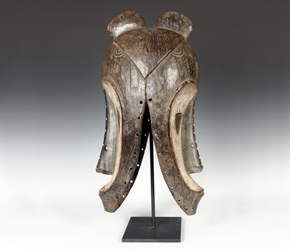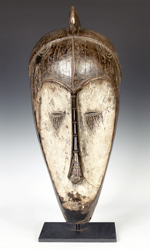Fang Ngil Mask
 |
|
Masks are danced throughout Africa for a variety of purposes. Arguably some of the most elegant and highly sought after are the masks from the Fang people. The white double-sided Ngil face mask comes from this group, who reside in what is now Equatorial Guinea, northwest Gabon, and South Cameroon. The Fang are an individual ethnic group that is related to the larger Beti-Pahuin group, which encompasses some 20 different ethnic groups, all of which inhabit West Africa.
 |
This mask represents a masquerading tradition that began to wane over sixty years ago. There is limited knowledge available about this tradition; and the practice in its truest form died out some 40 years ago. What is generally understood is that these masks were danced by members of the male Ngil society during the initiation of new members and during the persecution of wrong-doers. Masqueraders clad in raffia costumes and attended by helpers would materialize in the village after dark, illuminated by flickering torchlight. They were also used in dance performances that were meant to help discover members of the community who were responsible for practicing black magic, or malicious sorcery. It was believed these masks had power in their own right and could be enlisted to aid the dancer or the society in its mission.
This example is exceptionally unusual because it is double-sided; in essence, made up of two masks joined together yet carved from a single piece of wood. As a mask made to help pass judgment, it was presumably made this way because it could see from both sides.
Download this Article: Fang Double-headed Ngil Mask.pdf